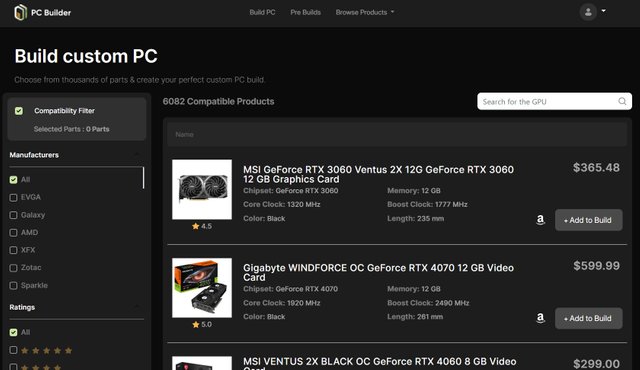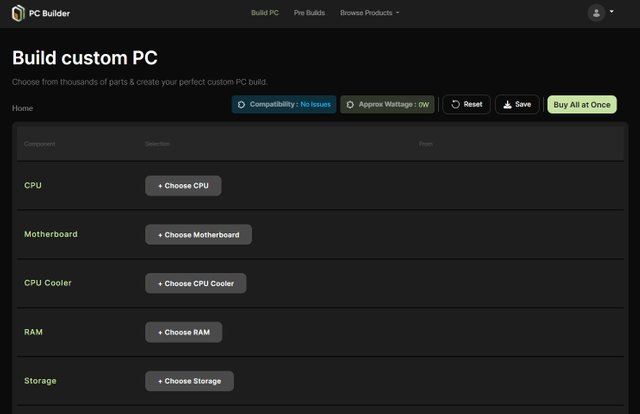How to Choose the Right GPU for Your Gaming Needs
Choosing the right GPU (Graphics Processing Unit) is one of the most important decisions when building or upgrading a gaming PC. Your GPU determines how well your system can handle modern games, video editing, and other graphics-intensive tasks. With so many options available, from budget-friendly GPUs to high-end gaming monsters, selecting the perfect one can be overwhelming.
This guide will walk you through the key factors to consider when picking a GPU to match your gaming needs. Plus, you can use tools like PC Builder and the GPU Comparison Tool to make an informed decision.
1. Understanding Your Gaming Needs
Before choosing a GPU, consider what kind of gaming experience you want.
Casual Gaming (1080p, 60 FPS, Low to Medium Settings)
If you mostly play casual or esports games like Minecraft, League of Legends, Valorant, or CS:GO, you don’t need a high-end GPU. A budget or mid-range card will be enough to deliver smooth gameplay at 1080p resolution.
Recommended GPUs:
NVIDIA GeForce GTX 1650 / 1660 Super
AMD Radeon RX 6500 XT / RX 6600
Mainstream Gaming (1080p, 144+ FPS, High to Ultra Settings)
For a competitive experience with high frame rates in games like Call of Duty: Warzone, Fortnite, or Apex Legends, you’ll need a mid-range GPU that can handle 1080p gaming with high settings.
Recommended GPUs:
NVIDIA RTX 3060 / RTX 4060
AMD Radeon RX 6700 XT
High-End Gaming (1440p, 144+ FPS, Ultra Settings)
If you want to enjoy the latest AAA games like Cyberpunk 2077, Red Dead Redemption 2, or Elden Ring at ultra settings in 1440p resolution, you’ll need a powerful GPU.
Recommended GPUs:
NVIDIA RTX 3070 / RTX 4070 Ti
AMD Radeon RX 6800 XT / RX 7900 XT
4K Ultra Gaming (60+ FPS, Max Settings)
For the ultimate gaming experience with ray tracing and 4K resolution, only the top-tier GPUs can deliver smooth performance.
Recommended GPUs:
NVIDIA RTX 4080 / RTX 4090
AMD Radeon RX 7900 XTX
2. Understanding GPU Specifications
To make an informed choice, you should understand key GPU specifications and how they impact gaming performance.
VRAM (Video Memory)
VRAM stores textures, shaders, and other game data. More VRAM allows for higher resolutions and better textures.
4GB VRAM – Basic gaming at 1080p
6GB-8GB VRAM – Ideal for 1080p high settings and 1440p gaming
10GB+ VRAM – Required for 4K gaming and ultra textures
CUDA Cores vs. Stream Processors
NVIDIA GPUs use CUDA cores.
AMD GPUs use Stream Processors.
Higher core counts generally mean better performance, but architecture efficiency matters too.
Ray Tracing & DLSS / FSR
Ray Tracing enhances lighting and reflections for realistic visuals (only available in RTX and RX 6000+ series).
DLSS (Deep Learning Super Sampling) by NVIDIA improves frame rates using AI upscaling.
FSR (FidelityFX Super Resolution) by AMD offers a similar performance boost for Radeon GPUs.
Power Consumption & PSU Requirements
Check your GPU’s power requirements and ensure your power supply unit (PSU) can handle it.
Budget GPUs: 300-450W PSU
Mid-Range GPUs: 550-750W PSU
High-End GPUs: 750W+ PSU
Use the PC Builder Power Supply Calculator to check if your PSU is sufficient for your chosen GPU.
3. Compatibility with Your PC
Motherboard Compatibility
Ensure your motherboard has a PCIe x16 slot (most modern motherboards do). For PCIe 4.0 or PCIe 5.0 GPUs, a compatible motherboard is recommended, but they still work in older PCIe 3.0 slots with slight performance reductions.
Case Size & GPU Dimensions
High-end GPUs like the RTX 4090 are large and require spacious cases. Check your case dimensions and ensure your GPU fits before purchasing.
Cooling & Airflow
Some GPUs generate more heat than others. If you choose a high-performance GPU, ensure your PC case has good airflow with enough cooling fans.
4. NVIDIA vs. AMD – Which One to Choose?
Both NVIDIA and AMD offer excellent GPUs, but they have some key differences:
Feature NVIDIA AMD
Ray Tracing Performance Better Decent
DLSS / FSR Support DLSS (More Advanced) FSR (More Open-Source)
Price-to-Performance Higher cost Better value for money
Driver Stability Generally stable Improving but some issues in older games
If you prioritize ray tracing, DLSS, and software stability, NVIDIA is the better choice. If you want better performance for the price and don’t mind minor driver issues, AMD offers great value.
5. Where to Buy & Compare GPUs
Use trusted websites and tools to compare GPUs before buying:
PC Builder GPU Comparison – Compare performance, specs, and prices.
PC Builder – Check GPU compatibility with other PC parts.
Newegg / Amazon / Micro Center – Buy GPUs from reputable retailers.
6. Future-Proofing Your GPU Purchase
If you want your GPU to last 3-5 years, consider:
Buying a slightly better GPU than your current needs to avoid frequent upgrades.
Checking upcoming game requirements to ensure longevity.
Waiting for price drops if new GPUs are launching soon.
Conclusion
Choosing the right GPU depends on your gaming needs, budget, and system compatibility. Whether you’re building a budget-friendly 1080p gaming rig or a high-end 4K powerhouse, there’s a perfect GPU for you.
To make the best decision, use tools like PC Builder and the GPU Comparison Tool to check specs, performance, and compatibility before purchasing.
With the right GPU, you’ll enjoy smoother gameplay, higher frame rates, and an overall better gaming experience! 🚀

